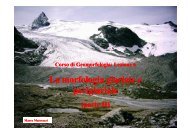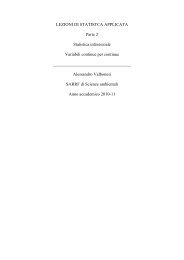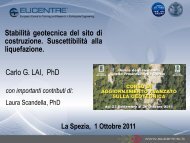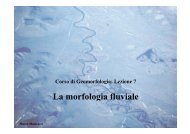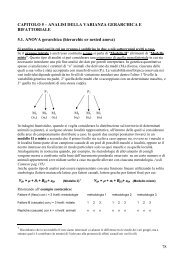Geomorfologia strutturale Parte II - Scuola di Scienze Ambientali
Geomorfologia strutturale Parte II - Scuola di Scienze Ambientali
Geomorfologia strutturale Parte II - Scuola di Scienze Ambientali
You also want an ePaper? Increase the reach of your titles
YUMPU automatically turns print PDFs into web optimized ePapers that Google loves.
Corso <strong>di</strong> <strong>Geomorfologia</strong>: Lezione 1<br />
<strong>Geomorfologia</strong> <strong>strutturale</strong><br />
(parte <strong>II</strong>)<br />
Bernar<strong>di</strong>no Gentili Marco Materazzi
Materazzi M. Corso <strong>di</strong> <strong>Geomorfologia</strong>: Lezione 1 <strong>Geomorfologia</strong> <strong>strutturale</strong> (parte <strong>II</strong>)<br />
SUPERFICIE DI SPIANAMENTO: corrisponde in generale ad una forma generata in<br />
completa assenza <strong>di</strong> controllo sia tettonico che <strong>strutturale</strong> sulla morfologia.<br />
Si trovano in letteratura <strong>di</strong>versi termini associati:<br />
PENEPIANO: termine coniato da DAVIS (1889) che lo inserì nel suo Ciclo derosione; in<strong>di</strong>ca una<br />
pianura derosione quale sta<strong>di</strong>o finale dellevoluzione del paesaggio da morfologie giovani aspre a<br />
morfologie vecchie e più dolci. E il risultato dellazione combinata <strong>di</strong> vari agenti morfogenetici (fiumi,<br />
clima, vento ecc.)<br />
PEDIMENT E PALEOSUPERFICIE: sono ambedue termini che in<strong>di</strong>cano una superficie <strong>di</strong> spianamento<br />
in senso lato, generatasi per meccanismi <strong>di</strong> erosione areale e non lineare (concetti associati <strong>di</strong> BIOSTASIA<br />
e RESISTASIA). Tali con<strong>di</strong>zioni sono generalmente associate a con<strong>di</strong>zioni climatiche <strong>di</strong> tipo arido-caldo e<br />
solitamente in con<strong>di</strong>zioni <strong>di</strong> relativa stabilità tettonica. Esempi classici sono quelli dellAfrica australe, del<br />
Sud America, dellIn<strong>di</strong>a e dellAustralia centrale, quin<strong>di</strong> <strong>di</strong> molte aree cratoniche tropicali. Ove queste<br />
morfologie si sono formate in fasi <strong>di</strong>fferenti, spesso alternate a perio<strong>di</strong> <strong>di</strong> sollevamento tettonico<br />
generalizzato, si parla <strong>di</strong> RILIEVO POLICICLICO<br />
Soprattutto nei testi anglosassoni, la superficie <strong>di</strong> spianamento viene in<strong>di</strong>cata con il termine BEVEL<br />
BEVELLED CUESTA (cuesta troncata)<br />
o
Materazzi M. Corso <strong>di</strong> <strong>Geomorfologia</strong>: Lezione 1 <strong>Geomorfologia</strong> <strong>strutturale</strong> (parte <strong>II</strong>)<br />
Schema <strong>di</strong> rilievo policiclico. Da Derruau, ri<strong>di</strong>segnato.
Materazzi M. Corso <strong>di</strong> <strong>Geomorfologia</strong>: Lezione 1 <strong>Geomorfologia</strong> <strong>strutturale</strong> (parte <strong>II</strong>)<br />
Pe<strong>di</strong>ment formation and pluvial morphogenesis in the Mojave Desert, California
Materazzi M. Corso <strong>di</strong> <strong>Geomorfologia</strong>: Lezione 1 <strong>Geomorfologia</strong> <strong>strutturale</strong> (parte <strong>II</strong>)<br />
Penepiano fossilizzato dalle Arenarie <strong>di</strong> A<strong>di</strong>grat, Etiopia settentrionale. Foto Ugo Sauro.
Materazzi M. Corso <strong>di</strong> <strong>Geomorfologia</strong>: Lezione 1 <strong>Geomorfologia</strong> <strong>strutturale</strong> (parte <strong>II</strong>)<br />
Superficie a debole energia del rilievo fossilizzata da una crosta lateritica.<br />
Valle Tekezé, Eritrea meri<strong>di</strong>onale. Foto Ugo Sauro.
Materazzi M. Corso <strong>di</strong> <strong>Geomorfologia</strong>: Lezione 1 <strong>Geomorfologia</strong> <strong>strutturale</strong> (parte <strong>II</strong>)<br />
Il penepiano paleozoico del New South Wales e la "Great Escarpment<br />
presso Armidale (Australia). Foto Clifford Ollier.
Materazzi M. Corso <strong>di</strong> <strong>Geomorfologia</strong>: Lezione 1 <strong>Geomorfologia</strong> <strong>strutturale</strong> (parte <strong>II</strong>)<br />
Il bevel della Croda del Becco negli altopiani ampezzani. Foto Ugo Sauro
Materazzi M. Corso <strong>di</strong> <strong>Geomorfologia</strong>: Lezione 1 <strong>Geomorfologia</strong> <strong>strutturale</strong> (parte <strong>II</strong>)<br />
Le morfologie associate alle faglie sono generalmente forme tettoniche, sebbene spesso abbiano un carattere più<br />
localizzato e ancor più spesso si combinino con altri agenti morfogenetici per generare forme più complesse<br />
Tipologia<br />
delle faglie.
Materazzi M. Corso <strong>di</strong> <strong>Geomorfologia</strong>: Lezione 1 <strong>Geomorfologia</strong> <strong>strutturale</strong> (parte <strong>II</strong>)<br />
Le principali forme tettoniche associate alle faglie sono:<br />
HORST E GRABEN: termine<br />
SCARPATE DI FAGLIA: termine<br />
FACCETTE TRIANGOLARI O TRAPEZOIDALI: termine<br />
FAGLIAZIONI DI SUPERFICIE: termine<br />
Le principali forme <strong>di</strong> erosione selettiva associate alle faglie sono:<br />
SCARPATE DI LINEA DI FAGLIA: termine<br />
VERSANTE DI FAGLIA: termine<br />
RETICOLO IDROGRAFICO NEI SISTEMI DI FAGLIA: termine
Materazzi M. Corso <strong>di</strong> <strong>Geomorfologia</strong>: Lezione 1 <strong>Geomorfologia</strong> <strong>strutturale</strong> (parte <strong>II</strong>)<br />
Lazione della tettonica <strong>di</strong>stensiva dà luogo alla formazione <strong>di</strong><br />
rilievi e depressioni<br />
Inversione del rilievo in un Graben. Da<br />
D. Johnson, ri<strong>di</strong>segnato.
Materazzi M. Corso <strong>di</strong> <strong>Geomorfologia</strong>: Lezione 1 <strong>Geomorfologia</strong> <strong>strutturale</strong> (parte <strong>II</strong>)<br />
Graben (Nazareth, Ethiopian Rift)
Materazzi M. Corso <strong>di</strong> <strong>Geomorfologia</strong>: Lezione 1 <strong>Geomorfologia</strong> <strong>strutturale</strong> (parte <strong>II</strong>)<br />
Esempio <strong>di</strong> morfologia legata ai sovrascorrimenti; lesempio del sovrascorrimento dei Mti Sibillini. In primo<br />
piano il Monte Vettore (panoramica da SSE) ed il contatto tra i calcari mesozoici e la formazione terrigena della<br />
Laga.
Materazzi M. Corso <strong>di</strong> <strong>Geomorfologia</strong>: Lezione 1 <strong>Geomorfologia</strong> <strong>strutturale</strong> (parte <strong>II</strong>)<br />
Scarpata <strong>di</strong> faglia (A) e scarpata <strong>di</strong><br />
faglia degradata (B). Da Miller e<br />
Westerback, ri<strong>di</strong>segnato.
Materazzi M. Corso <strong>di</strong> <strong>Geomorfologia</strong>: Lezione 1 <strong>Geomorfologia</strong> <strong>strutturale</strong> (parte <strong>II</strong>)
Materazzi M. Corso <strong>di</strong> <strong>Geomorfologia</strong>: Lezione 1 <strong>Geomorfologia</strong> <strong>strutturale</strong> (parte <strong>II</strong>)<br />
Huge scarp along the Bogd left-lateral fault system, Gobi desert
Materazzi M. Corso <strong>di</strong> <strong>Geomorfologia</strong>: Lezione 1 <strong>Geomorfologia</strong> <strong>strutturale</strong> (parte <strong>II</strong>)<br />
Aerial view of Holocene fault scarp on the Wasatch fault, near American Fork Canyon, Utah
Materazzi M. Corso <strong>di</strong> <strong>Geomorfologia</strong>: Lezione 1 <strong>Geomorfologia</strong> <strong>strutturale</strong> (parte <strong>II</strong>)<br />
Aerial view toward the NE of the Pu`u Kapukapu fault scarp (maximum height about 320 m) in the<br />
Hilina fault system, south flank of Kilauea Volcano, Hawaii islands.
Materazzi M. Corso <strong>di</strong> <strong>Geomorfologia</strong>: Lezione 1 <strong>Geomorfologia</strong> <strong>strutturale</strong> (parte <strong>II</strong>)<br />
Scarpata <strong>di</strong> faglia cosismica (1872) <strong>di</strong> Lone Pine, Owens Valley, California, che <strong>di</strong>sloca un conoide<br />
attivo.
Materazzi M. Corso <strong>di</strong> <strong>Geomorfologia</strong>: Lezione 1 <strong>Geomorfologia</strong> <strong>strutturale</strong> (parte <strong>II</strong>)<br />
Scarpata <strong>di</strong> faglia (Garibol<strong>di</strong> complex, Ethiopian Rift)
Materazzi M. Corso <strong>di</strong> <strong>Geomorfologia</strong>: Lezione 1 <strong>Geomorfologia</strong> <strong>strutturale</strong> (parte <strong>II</strong>)<br />
Scarpata <strong>di</strong> faglia (Nazareth, Ethiopian Rift)
Materazzi M. Corso <strong>di</strong> <strong>Geomorfologia</strong>: Lezione 1 <strong>Geomorfologia</strong> <strong>strutturale</strong> (parte <strong>II</strong>)<br />
Hanaupah fault scarp Death Valley
Materazzi M. Corso <strong>di</strong> <strong>Geomorfologia</strong>: Lezione 1 <strong>Geomorfologia</strong> <strong>strutturale</strong> (parte <strong>II</strong>)<br />
Fault scarp of the Lost River normal fault above Mackay, Idaho, in 1987
Materazzi M. Corso <strong>di</strong> <strong>Geomorfologia</strong>: Lezione 1 <strong>Geomorfologia</strong> <strong>strutturale</strong> (parte <strong>II</strong>)
Materazzi M. Corso <strong>di</strong> <strong>Geomorfologia</strong>: Lezione 1 <strong>Geomorfologia</strong> <strong>strutturale</strong> (parte <strong>II</strong>)<br />
Free-face su piano <strong>di</strong> faglia, sviluppatasi in occasione del terremoto umbro-marchigiano del 26<br />
settembre 1997 (Costa, MC)
Materazzi M. Corso <strong>di</strong> <strong>Geomorfologia</strong>: Lezione 1 <strong>Geomorfologia</strong> <strong>strutturale</strong> (parte <strong>II</strong>)<br />
Porzione dello specchio <strong>di</strong> faglia del M. Parasano, in Abruzzo, localmente messo in luce per erosione<br />
selettiva dei depositi <strong>di</strong> versante.
Materazzi M. Corso <strong>di</strong> <strong>Geomorfologia</strong>: Lezione 1 <strong>Geomorfologia</strong> <strong>strutturale</strong> (parte <strong>II</strong>)<br />
Esumazione <strong>di</strong> una scarpata <strong>di</strong><br />
faglia. Lattività della faglia si<br />
conclude nella fase A. I lembi<br />
residui della copertura alluvionale,<br />
preservati allinterno delle valli (fase<br />
C), consentono il riconoscimento<br />
della genesi <strong>di</strong> questa<br />
morfostruttura. Le frecce in<strong>di</strong>cano in<br />
quale fase la faglia è stata attiva. Da<br />
D. Johnson, mo<strong>di</strong>ficato.
Materazzi M. Corso <strong>di</strong> <strong>Geomorfologia</strong>: Lezione 1 <strong>Geomorfologia</strong> <strong>strutturale</strong> (parte <strong>II</strong>)<br />
Scarpata esumata, Massiccio del Marguareis (CN).
Materazzi M. Corso <strong>di</strong> <strong>Geomorfologia</strong>: Lezione 1 <strong>Geomorfologia</strong> <strong>strutturale</strong> (parte <strong>II</strong>)<br />
Il pen<strong>di</strong>o <strong>di</strong> faglia dei Monti della Duchessa-Monte Velino da M. S. Mauro.
Materazzi M. Corso <strong>di</strong> <strong>Geomorfologia</strong>: Lezione 1 <strong>Geomorfologia</strong> <strong>strutturale</strong> (parte <strong>II</strong>)<br />
Versante <strong>di</strong> faglia del Monte Vettore (Marche, Italia)
Materazzi M. Corso <strong>di</strong> <strong>Geomorfologia</strong>: Lezione 1 <strong>Geomorfologia</strong> <strong>strutturale</strong> (parte <strong>II</strong>)
Materazzi M. Corso <strong>di</strong> <strong>Geomorfologia</strong>: Lezione 1 <strong>Geomorfologia</strong> <strong>strutturale</strong> (parte <strong>II</strong>)
Materazzi M. Corso <strong>di</strong> <strong>Geomorfologia</strong>: Lezione 1 <strong>Geomorfologia</strong> <strong>strutturale</strong> (parte <strong>II</strong>)<br />
Faccette triangolari nella valle dellArno fra Le Sieci e Rosano, a monte <strong>di</strong> Firenze
Materazzi M. Corso <strong>di</strong> <strong>Geomorfologia</strong>: Lezione 1 <strong>Geomorfologia</strong> <strong>strutturale</strong> (parte <strong>II</strong>)<br />
Sviluppo, per erosione selettiva <strong>di</strong> una gra<strong>di</strong>nata <strong>di</strong> faglia, <strong>di</strong> una scarpata <strong>di</strong> linea <strong>di</strong> faglia resequente (cioè<br />
congruente rispetto alla struttura tettonica, a sinistra) e <strong>di</strong> una scarpata <strong>di</strong> linea <strong>di</strong> faglia obsequente (incongrua,<br />
speculare rispetto alla struttura, a destra). È opportuno evidenziare che, in questo schema, lattività delle faglie<br />
precede il modellamento erosivo. Da Miller & Westerback, ri<strong>di</strong>segnato.
Materazzi M. Corso <strong>di</strong> <strong>Geomorfologia</strong>: Lezione 1 <strong>Geomorfologia</strong> <strong>strutturale</strong> (parte <strong>II</strong>)<br />
Scarpata <strong>di</strong> linea <strong>di</strong> faglia al contatto fra i calcari del Lias e gli ero<strong>di</strong>bili se<strong>di</strong>menti neogenici. Plakias,<br />
Isola <strong>di</strong> Creta.
Materazzi M. Corso <strong>di</strong> <strong>Geomorfologia</strong>: Lezione 1 <strong>Geomorfologia</strong> <strong>strutturale</strong> (parte <strong>II</strong>)<br />
Si definisce PATTERN IDROGRAFICO una configurazione delle linee <strong>di</strong> impluvio (e quin<strong>di</strong> dellidrografia superficiale) che tiene<br />
conto del loro <strong>di</strong>segno, della densità e del tipo <strong>di</strong> confluenza. Esistono <strong>di</strong>versi tipi:<br />
DENDRITICO: tipico <strong>di</strong> terreni omogenei, impermeabili e a limitata<br />
acclività (rocce magmatiche e metamorfiche solitamente senza un preciso<br />
controllo tettonico)<br />
SUBDENDRITICO: come il precedente ma caratterizzato da un certo<br />
controllo tettonico<br />
PINNATO: <strong>di</strong>fferente dal primo per lesigua lunghezza dei collettori<br />
secondari; tipico <strong>di</strong> terreni omogenei, impermeabili a morfologia<br />
pianeggiante<br />
DIVERGENTE: caratterizza i delta e le conoi<strong>di</strong><br />
CONVERGENTE: terreni poco permeabili a sensibile acclività<br />
PARALLELO: terreni impermeabili, sensibile acclività e controllo da<br />
parte <strong>di</strong> fratture sub-parallele<br />
ANGOLATO: controllo struttrale <strong>di</strong> due fasci <strong>di</strong> faglie, fratture o<br />
<strong>di</strong>scontinuità litologiche<br />
RADIALE CENTRIFUGO: tipico dei coni vulcanici, domi tettonici,<br />
<strong>di</strong>apiri, inselberg ecc.<br />
RADIALE CENTRIPETO: tipico delle depressioni (vulcaniche,<br />
carsiche, tettoniche ecc.)<br />
ANULARE: tipico <strong>di</strong> rilievi pseudo-conici a gra<strong>di</strong>nata con alternanze <strong>di</strong><br />
litotipi a <strong>di</strong>versa ero<strong>di</strong>bilità<br />
MEANDRIFORME: caratteristico delle pianure alluvionali<br />
ANASTOMIZZATO: tipico <strong>di</strong> aree a notevole se<strong>di</strong>mentazione come<br />
zone pedemontane o proglaciali
Materazzi M. Corso <strong>di</strong> <strong>Geomorfologia</strong>: Lezione 1 <strong>Geomorfologia</strong> <strong>strutturale</strong> (parte <strong>II</strong>)<br />
Varie tipologie <strong>di</strong><br />
reticoli dendritici.
Materazzi M. Corso <strong>di</strong> <strong>Geomorfologia</strong>: Lezione 1 <strong>Geomorfologia</strong> <strong>strutturale</strong> (parte <strong>II</strong>)
Materazzi M. Corso <strong>di</strong> <strong>Geomorfologia</strong>: Lezione 1 <strong>Geomorfologia</strong> <strong>strutturale</strong> (parte <strong>II</strong>)
Materazzi M. Corso <strong>di</strong> <strong>Geomorfologia</strong>: Lezione 1 <strong>Geomorfologia</strong> <strong>strutturale</strong> (parte <strong>II</strong>)
Materazzi M. Corso <strong>di</strong> <strong>Geomorfologia</strong>: Lezione 1 <strong>Geomorfologia</strong> <strong>strutturale</strong> (parte <strong>II</strong>)
Materazzi M. Corso <strong>di</strong> <strong>Geomorfologia</strong>: Lezione 1 <strong>Geomorfologia</strong> <strong>strutturale</strong> (parte <strong>II</strong>)
Materazzi M. Corso <strong>di</strong> <strong>Geomorfologia</strong>: Lezione 1 <strong>Geomorfologia</strong> <strong>strutturale</strong> (parte <strong>II</strong>)<br />
Esempio <strong>di</strong> reticolo rettangolare. I segmenti ad andamento WSW-ENE sono impostati lungo il Sistema della Cremosina. I<br />
segmenti ortogonali a questi seguono per lo più il pen<strong>di</strong>o regionale, talora in presenza <strong>di</strong> un controllo <strong>strutturale</strong>
Materazzi M. Corso <strong>di</strong> <strong>Geomorfologia</strong>: Lezione 1 <strong>Geomorfologia</strong> <strong>strutturale</strong> (parte <strong>II</strong>)<br />
Rapporti fra reticolo<br />
idrografico e strutture a<br />
pieghe in un settore<br />
dellAppennino umbro.
Materazzi M. Corso <strong>di</strong> <strong>Geomorfologia</strong>: Lezione 1 <strong>Geomorfologia</strong> <strong>strutturale</strong> (parte <strong>II</strong>)<br />
Esempio <strong>di</strong> reticolo rettangolare (scudo canadese)
Materazzi M. Corso <strong>di</strong> <strong>Geomorfologia</strong>: Lezione 1 <strong>Geomorfologia</strong> <strong>strutturale</strong> (parte <strong>II</strong>)<br />
Sono ambedue termini che servono per spiegare lapparente incongruenza fra struttura geologica ed<br />
idrografia superficiale<br />
ANTECEDENZA: fenomeno<br />
nel quale un corso dacqua (più<br />
antico quin<strong>di</strong> antecedente)<br />
mantiene il suo tracciato<br />
attraverso una struttura tettonica<br />
attiva<br />
Schema classico <strong>di</strong> antecedenza. Da Lobeck, ri<strong>di</strong>segnato.
Materazzi M. Corso <strong>di</strong> <strong>Geomorfologia</strong>: Lezione 1 <strong>Geomorfologia</strong> <strong>strutturale</strong> (parte <strong>II</strong>)<br />
SOVRIMPOSIZIONE: detto anche EPIGENESI, è il fenomeno che in<strong>di</strong>ca la permanenza del tracciato <strong>di</strong><br />
un corso dacqua durante lincisione quando esso incontra in profon<strong>di</strong>tà con<strong>di</strong>zioni litostrutturali <strong>di</strong>verse da<br />
quelle che avevano determinato il tracciato stesso (Castiglioni, 1986)<br />
Schema classico <strong>di</strong> sovrimposizione. Da Lobeck, ri<strong>di</strong>segnato.
Materazzi M. Corso <strong>di</strong> <strong>Geomorfologia</strong>: Lezione 1 <strong>Geomorfologia</strong> <strong>strutturale</strong> (parte <strong>II</strong>)<br />
Reticolo idrografico e morfostrutture<br />
dellAppennino umbro-marchigiano; il<br />
tracciato fluviale si è qui impostato per<br />
il fenomeno dellantecedenza e si è poi<br />
approfon<strong>di</strong>to per sovrimposizione.
Materazzi M. Corso <strong>di</strong> <strong>Geomorfologia</strong>: Lezione 1 <strong>Geomorfologia</strong> <strong>strutturale</strong> (parte <strong>II</strong>)
Materazzi M. Corso <strong>di</strong> <strong>Geomorfologia</strong>: Lezione 1 <strong>Geomorfologia</strong> <strong>strutturale</strong> (parte <strong>II</strong>)<br />
Fault scarp (bright yellowish line at base of mountains), which formed in association with the<br />
1915 Pleasant Valley earthquake



